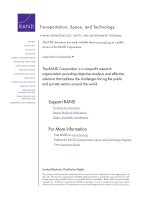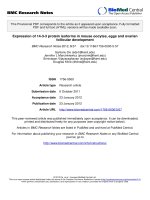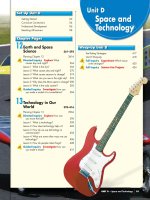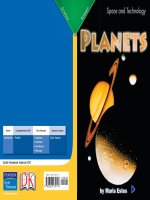3 17 science in our lives (space and technology)
Bạn đang xem bản rút gọn của tài liệu. Xem và tải ngay bản đầy đủ của tài liệu tại đây (3.88 MB, 14 trang )
Space and Technology
by Ann Howard
Genre
Nonfiction
Comprehension Skill
Sequence
Text Features
• Captions
• Call Outs
• Glossary
Science Content
Technology
Scott Foresman Science 3.17
ISBN 0-328-13856-8
ì<(sk$m)=bdifdb< +^-Ä-U-Ä-U
Vocabulary
What did you learn?
computer
1. What invention helped the Romans get water to
their cities? by Ann Howard
invention
Science in Our Lives
technology
2. How has modern technology changed kitchens?
tool
3. Why are optical fibers better than wires?
Illustrations: 4, 14, 18, 21 Robert Ulrich
Photographs: Every effort has been made to secure permission and provide appropriate credit for
photographic material. The publisher deeply regrets any omission and pledges to correct errors called to its
attention in subsequent editions. Unless otherwise acknowledged, all photographs are the property of Scott
Foresman, a division of Pearson Education. Photo locators denoted as follows: Top (T), Center (C), Bottom
(B), Left (L), Right (R), Background (Bkgd).
Opener: ©Volvox/Index Stock Imagery; Title Page: ©Bill Varie/Corbis; 2 ©Dennis Degnan/Corbis; 3
©Mimmo Jodice/Corbis; 5 (TC) ©Billy E. Barnes/Stock Boston, (BR) ©Comstock Images/Getty Images;
6 ©Bill Varie/Corbis; 8 Getty Images; 9 (BR) ©Courtesy of JVC/DK Images, (TR) Getty Images; 10 (CL)
NOAA, (CC) ©Time Life Pictures/Getty Images, (BR) ©Myrleen Ferguson Cate/PhotoEdit; 11 (B) ©Bob
Daemmrich/The Image Works, Inc., (CR) ©Stone/Getty Images; 12 (T) ©Jay Dickman/Corbis, (CR)
©Imperial War Museum/©DK Images; 13 (TL) ©Raymond Gehman/Corbis, (TR) ©ASAP Ltd./Index
Stock Imagery, (CC) ©Photodisc/Getty Images; 14 DK Images; 16 ©David Muench/Corbis; 17 ©Terry
Thompson/Panoramic Images; 18 ©Lester Lefkowitz/Corbis; 19 ©Terrence Moore/Woodfin Camp &
Associates; 20 ©The Image Bank/Getty Images; 22 ©Photodisc/Getty Images
ISBN: 0-328-13856-8
Copyright © Pearson Education, Inc.
All Rights Reserved. Printed in the United States of America. This publication is
protected by Copyright and permission should be obtained from the publisher prior
to any prohibited reproduction, storage in a retrieval system, or transmission in any
form by any means, electronic, mechanical, photocopying, recording, or likewise. For
information regarding permissions, write to: Permissions Department, Scott Foresman,
1900 East Lake Avenue, Glenview, Illinois 60025.
3 4 5 6 7 8 9 10 V010 13 12 11 10 09 08 07 06 05
4.
In this book you have read
about water mills and windmills. Write to explain
how each works. Use examples from the book.
5.
Sequence Explain how solar panels heat
water that goes into a hot water tank.
How does technology
affect our lives?
Finding New Ways
Arches were an important
invention in ancient Rome. An
invention is something made
for the first time. The Romans
needed water for their cities.
People always want to know how things work. As
They learned that arches with a
people learn things, they get new ideas. People invent
central stone could hold heavy
tools to help. A tool helps people do work more easily
things. They used these arches
or in a new way. This means people use technology.
to make bridges. Bridges were
Technology is using knowledge to design new tools
used to move water to the cities.
and new ways to do things. Tools can be simple or
The keystone, or central
stone wedged at the top,
keeps the stones of the
arch in place.
complicated.
2
3
Technology in Your Home
Your home is made up of many parts. These parts
form systems. The systems must work together.
What happens when you flush the toilet? You use
Some water in the plumbing system goes through a
heater. The electrical system is linked to it. Electricity
heats the water. Together, the plumbing and electrical
systems make it possible for you to take a hot shower.
the plumbing system. This system is made of faucets,
drains, sinks, and pipes. These parts all work together.
Can you find the parts that
belong to each system in this
house?
Systems in a House
These air conditioners are
part of a cooling system.
Framing
Roofing and waterproofing
Electrical
Plumbing
Heating/cooling
4
5
How is a house built? Technology is used from the
Particle boards are used in walls. The boards are
beginning. Boards are placed in very special ways.
made of wood chips. Such wood chips used to be
Builders know where to place boards to make a
burned. When burned, they caused pollution. New
house strong. Each part must be put in the right
technology turns those chips into strong boards that
place to make a strong frame. This is why planning
are used in walls.
is important.
Wood chips are pressed
and glued together to
make particle boards.
6
7
Technology Yesterday, Today, and Tomorrow
In the past, people played records to listen to music.
Two hundred years ago, kitchens did not have
As a record spun, a metal needle moved along the
electricity. There was no refrigerator. People had to
grooves of the record. Then a machine turned the
burn wood in a stove to cook food. Cooking meals
vibrations from the needle into music. Today’s DVD
could take all day.
players use light beams to read the information
People began inventing new things. First, ice boxes
on computer-coded plastic discs. Then a computer
were used to keep food cold. Then, electric refrigerators
changes the information from the discs into images
replaced ice boxes. Today, microwave ovens cook food
on a screen.
in seconds. Electric dishwashers wash dishes for you.
Some people think that computers will run your
entire home in the future. A refrigerator may be able
Airtight seals for plastic bowls
were invented in 1947.
to order food when it becomes empty. Technology may
make this possible.
Both CD and DVD
players use light beams.
The light beams play
back the music and
movies on the discs.
The non-stick coating
on this pan was
invented in 1954.
8
9
Tools for Processing Information
What are some
new technologies?
A computer stores, processes, and sends electronic
information very fast! Computer technology is all
around you. Computer chips are found in digital
Tools for Extending Our Senses
Sailors once used math and the stars to find their
way. Now they can use a Global Positioning System
(GPS). This system uses space satellites. The satellites
send signals. A ship’s GPS computer uses the signals
like a map. Many cars today have a GPS.
Satellites can be used in many other ways.
Forecasters use pictures taken by satellites to predict
watches, cameras, and even cars.
Optical fibers are making computers better. These
fibers are strands of bendable glass that carry light.
The fibers are replacing copper wires in computer and
telephone systems. Optical fibers do not get hot, as
wires do. They also take up less space than wires. They
can even carry much more information.
Optical fibers (right) are used
in communication systems now
instead of copper wires (left).
the weather.
Satellites can
track cars on
the road.
Changing to new fiber optic
technology requires a lot of work.
Cameras in satellites
help in predicting
the weather.
10
11
Highway engineers
design roads such as the
ones pictured above.
Highways were first
built in the United
States so military
vehicles could move
quickly.
Tools for Transporting Materials
Roads are important to us. We use them to get to
school and to work. We use them to transport goods.
We use them to visit friends and family.
The National Highway System is made up of
over 160,000 miles of highways. These highways go
between the states in our country. About 80 million
trucks haul supplies on these highways. About 120
million cars move people from place to place.
12
Roads are not the only way of moving people and
things. People and freight are moved using trains and
planes too.
But rivers were the first transportation system in
the United States. Rivers are still full of boats moving
goods today. Technology will always keep things
moving!
13
Unexpected Uses
Do you watch TV? Glass tubes were used to show
Technology uses are not always planned. The
the picture in early television sets and computers. But
microwave oven is a good example. In 1946 Percy
these tubes were big and heavy. With new technology,
Spencer was working to improve radar. He was testing
screens are light in weight. The LCD screen was
a light bulb. The bulb used microwave energy.
invented in 1970 by James Fergason. LCD stands for
One day, Spencer stood by the tube. A candy bar
liquid crystal display. Liquid crystals control the flow
in his pocket melted. Spencer then placed popcorn
of light. This makes an image on the screen. These
kernels near the microwave energy. They popped.
screens do not need heavy glass tubes. They are also
Spencer discovered that microwaves could cook foods
flat in shape. So they take up less space.
fast! Soon, the microwave oven was invented.
This is Percy Spencer’s
design of how a microwave
oven would work.
Wave guide
Food to be
cooked
Flat LCD screens take up less
space than older glass screens.
Magnetron
oscillator
14
Conveyor belt
15
How does technology
help us get energy?
Using Energy
Put in a DVD. Heat up a snack in the microwave.
Windmills were also used to do work. Windmills use
wind for power. Turning blades move gears in a box.
Energy in the gears moves a rod up and down. This
can be used to pump water from under the ground.
There are good and bad things about using
windmills and water mills. Both wind and water
Just be sure everything is plugged in! None of this
are renewable sources of energy. They do not cause
would be possible without electricity.
pollution. But they don’t make enough power for all
Before electricity, people used energy from wind and
our needs.
water. Water-powered mills were built near rivers. The
force of flowing water turned a wheel. At a sawmill,
the wheel turned rods, gears, and belts. This powered
saws that cut wood.
Windmills use wind
to pump water.
16
17
Producing Electricity
Hydroelectric power does not make much pollution.
Waterwheel technology is still used in hydroelectric
power dams. These dams are built on rivers. Water in
But the lakes behind dams can cause flooding.
There are other ways to make electricity. One way is
lakes behind the dams stores potential energy. To free
by burning coal, oil, or natural gas. The heat created
this energy, gates let water into a power station. The
is used to boil water. The boiling water makes steam.
flowing water spins the blades of a waterwheel in a
Pressure from the steam turns wheels in electricity
turbine. The kinetic energy of water is changed into
generators.
electricity in a generator. People use the electricity
This technology makes plenty of electricity. But it
also creates the problem of air pollution.
for power.
This generator
can change the
kinetic energy of
flowing water into
electricity.
Hoover Dam is
one of the largest
dams in the
world.
Connected to each
generator is a
turbine. The energy
of moving water
spins the blades in
the turbine.
18
19
Future Sources of Energy
Our need for energy keeps growing. How will we
Thanks to new technology, solar energy costs less.
People can buy panels to put on their roofs. But these
panels make hot water, not electricity.
keep meeting this need?
Solar energy may be one answer. This energy comes
Here’s how it works. First, water runs through small
from sunlight. Special panels collect sunlight. Each
tubes. Next, the Sun’s rays are changed into heat. This
panel has lots of small solar cells. They change energy
happens when the panels absorb the rays. Then the
from the Sun into electricity. Solar energy is common
heat warms the water in the tubes. Finally, the hot
in deserts. The Sun shines there much of the time.
water flows into a tank. It is stored until it is used.
Solar panels collect
the Sun’s rays.
Solar energy heats
the water held in this
appliance.
20
21
Wind energy is helping too. Windmills are put in
Technology makes new ways of creating electricity
places that get strong winds. Huge blades change the
possible. It also helps the systems in your home to
kinetic energy of wind into electrical energy.
work together. Technology helps us every day. It has
Computers are used to tell when wind conditions
have changed. Motors then adjust the direction and
changed our lives in many ways. Who knows how
technology will change our lives in the future.
angle of the blades. This way, electricity is made
whenever strong winds blow.
Windmill blade wheels can be
wider than a football field is long!
22
23
Glossary
Vocabulary
What did you learn?
computer
computer
a machine that stores, processes, and
invention
sends electronic information quickly
1. What invention helped the Romans get water to
their cities?
invention
technology
something made for the first time
2. How has modern technology changed kitchens?
technology
the use of knowledge to make new
3. Why are optical fibers better than wires?
tool
tool
tools and new ways to do things
4.
In this book you have read
about water mills and windmills. Write to explain
how each works. Use examples from the book.
5.
Sequence Explain how solar panels heat
water that goes into a hot water tank.
something that helps people do work
more easily
Illustrations: 4, 14, 18, 21 Robert Ulrich
Photographs: Every effort has been made to secure permission and provide appropriate credit for
photographic material. The publisher deeply regrets any omission and pledges to correct errors called to its
attention in subsequent editions. Unless otherwise acknowledged, all photographs are the property of Scott
Foresman, a division of Pearson Education. Photo locators denoted as follows: Top (T), Center (C), Bottom
(B), Left (L), Right (R), Background (Bkgd).
Opener: ©Volvox/Index Stock Imagery; Title Page: ©Bill Varie/Corbis; 2 ©Dennis Degnan/Corbis; 3
©Mimmo Jodice/Corbis; 5 (TC) ©Billy E. Barnes/Stock Boston, (BR) ©Comstock Images/Getty Images;
6 ©Bill Varie/Corbis; 8 Getty Images; 9 (BR) ©Courtesy of JVC/DK Images, (TR) Getty Images; 10 (CL)
NOAA, (CC) ©Time Life Pictures/Getty Images, (BR) ©Myrleen Ferguson Cate/PhotoEdit; 11 (B) ©Bob
Daemmrich/The Image Works, Inc., (CR) ©Stone/Getty Images; 12 (T) ©Jay Dickman/Corbis, (CR)
©Imperial War Museum/©DK Images; 13 (TL) ©Raymond Gehman/Corbis, (TR) ©ASAP Ltd./Index
Stock Imagery, (CC) ©Photodisc/Getty Images; 14 DK Images; 16 ©David Muench/Corbis; 17 ©Terry
Thompson/Panoramic Images; 18 ©Lester Lefkowitz/Corbis; 19 ©Terrence Moore/Woodfin Camp &
Associates; 20 ©The Image Bank/Getty Images; 22 ©Photodisc/Getty Images
ISBN: 0-328-13856-8
Copyright © Pearson Education, Inc.
All Rights Reserved. Printed in the United States of America. This publication is
protected by Copyright and permission should be obtained from the publisher prior
to any prohibited reproduction, storage in a retrieval system, or transmission in any
form by any means, electronic, mechanical, photocopying, recording, or likewise. For
information regarding permissions, write to: Permissions Department, Scott Foresman,
1900 East Lake Avenue, Glenview, Illinois 60025.
3 4 5 6 7 8 9 10 V010 13 12 11 10 09 08 07 06 05
24









